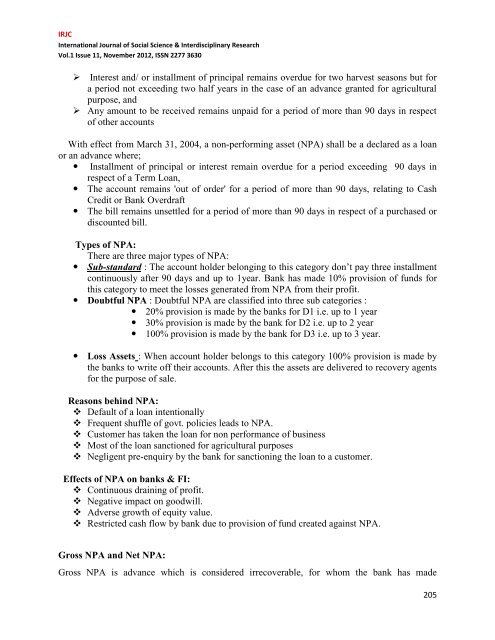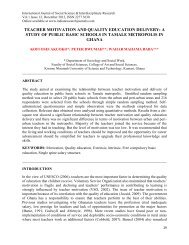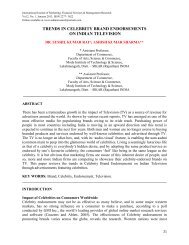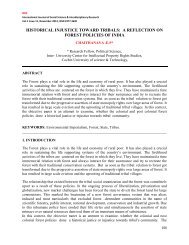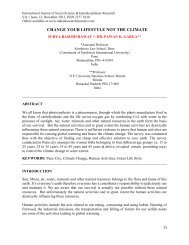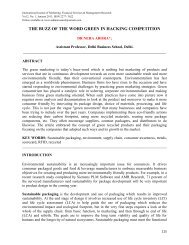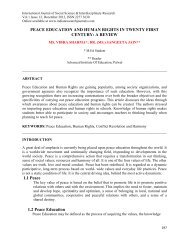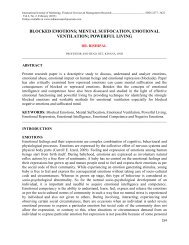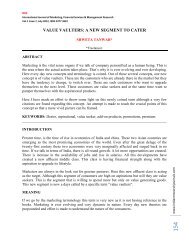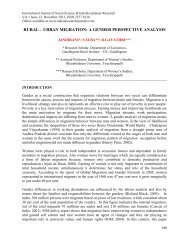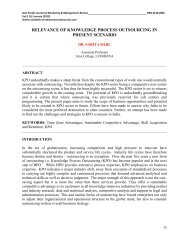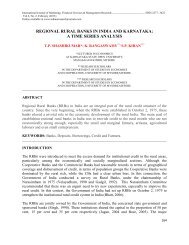management of non performing assets - a current scenario
management of non performing assets - a current scenario
management of non performing assets - a current scenario
You also want an ePaper? Increase the reach of your titles
YUMPU automatically turns print PDFs into web optimized ePapers that Google loves.
IRJC<br />
International Journal <strong>of</strong> Social Science & Interdisciplinary Research<br />
Vol.1 Issue 11, November 2012, ISSN 2277 3630<br />
‣ Interest and/ or installment <strong>of</strong> principal remains overdue for two harvest seasons but for<br />
a period not exceeding two half years in the case <strong>of</strong> an advance granted for agricultural<br />
purpose, and<br />
‣ Any amount to be received remains unpaid for a period <strong>of</strong> more than 90 days in respect<br />
<strong>of</strong> other accounts<br />
With effect from March 31, 2004, a <strong>non</strong>-<strong>performing</strong> asset (NPA) shall be a declared as a loan<br />
or an advance where;<br />
• Installment <strong>of</strong> principal or interest remain overdue for a period exceeding 90 days in<br />
respect <strong>of</strong> a Term Loan,<br />
• The account remains 'out <strong>of</strong> order' for a period <strong>of</strong> more than 90 days, relating to Cash<br />
Credit or Bank Overdraft<br />
• The bill remains unsettled for a period <strong>of</strong> more than 90 days in respect <strong>of</strong> a purchased or<br />
discounted bill.<br />
Types <strong>of</strong> NPA:<br />
There are three major types <strong>of</strong> NPA:<br />
• Sub-standard : The account holder belonging to this category don‟t pay three installment<br />
continuously after 90 days and up to 1year. Bank has made 10% provision <strong>of</strong> funds for<br />
this category to meet the losses generated from NPA from their pr<strong>of</strong>it.<br />
• Doubtful NPA : Doubtful NPA are classified into three sub categories :<br />
• 20% provision is made by the banks for D1 i.e. up to 1 year<br />
• 30% provision is made by the bank for D2 i.e. up to 2 year<br />
• 100% provision is made by the bank for D3 i.e. up to 3 year.<br />
• Loss Assets : When account holder belongs to this category 100% provision is made by<br />
the banks to write <strong>of</strong>f their accounts. After this the <strong>assets</strong> are delivered to recovery agents<br />
for the purpose <strong>of</strong> sale.<br />
Reasons behind NPA:<br />
Default <strong>of</strong> a loan intentionally<br />
Frequent shuffle <strong>of</strong> govt. policies leads to NPA.<br />
Customer has taken the loan for <strong>non</strong> performance <strong>of</strong> business<br />
Most <strong>of</strong> the loan sanctioned for agricultural purposes<br />
Negligent pre-enquiry by the bank for sanctioning the loan to a customer.<br />
Effects <strong>of</strong> NPA on banks & FI:<br />
Continuous draining <strong>of</strong> pr<strong>of</strong>it.<br />
Negative impact on goodwill.<br />
Adverse growth <strong>of</strong> equity value.<br />
Restricted cash flow by bank due to provision <strong>of</strong> fund created against NPA.<br />
Gross NPA and Net NPA:<br />
Gross NPA is advance which is considered irrecoverable, for whom the bank has made<br />
205


